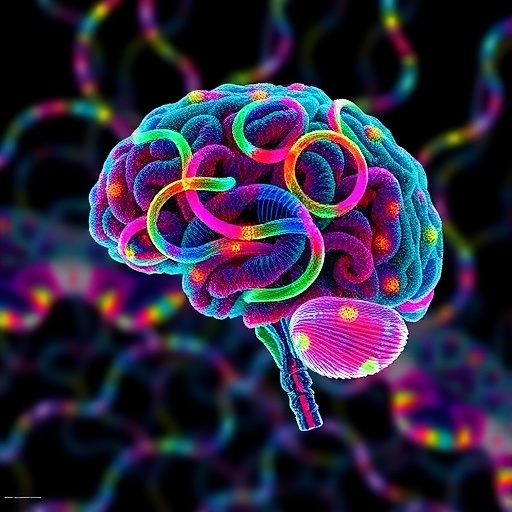For decades, vast regions of the human genome were dismissed as “junk DNA,” a genomic dark matter thought to be non-functional and evolutionarily irrelevant. However, a groundbreaking study from Lund University challenges this long-standing misconception by uncovering an active role for repetitive DNA sequences in early human brain development. Published recently in Cell Genomics, this work sheds light on how these enigmatic parts of our genome, previously ignored, are crucial for shaping the human brain and have profound implications for understanding neurological diseases.
Human DNA comprises an estimated three billion base pairs, yet only about 1.5% of this sequence codes for proteins. The remaining 98.5% was historically regarded as genetic filler, clutter without clear purpose. Modern genomics has slowly dismantled this binary view, revealing that these non-coding regions hold regulatory elements controlling gene expression across various cells and tissues. The new study from Johan Jakobsson’s laboratory at Lund University pushes this knowledge further by focusing on transposable elements — repetitive DNA sequences known as “jumping genes” — and their influence over early developmental processes in the brain.
Transposable elements, particularly the family known as LINE-1 (L1) retrotransposons, have posed significant challenges for geneticists due to their repetitive nature and mobility within the genome. L1 elements can copy and insert themselves into new loci, reshaping genomic architecture. While historically thought of as genomic parasites or relics, these elements can in fact act as potent regulators of gene activity. By employing cutting-edge CRISPR gene-editing techniques combined with advanced sequencing platforms, the Lund team was able to selectively silence L1 elements in human induced pluripotent stem cells (iPSCs) and observe the resulting biological effects in brain organoids — miniature, simplified brain models grown in vitro.
Their results overturn previous assumptions that L1 elements remain dormant during early development. The data reveal that these retrotransposons are highly active in human pluripotent stem cells and contribute to fine-tuning gene expression patterns crucial for the maturation and organization of developing neural tissue. When the team inhibited L1 activity, they observed striking disruptions in gene regulatory networks alongside abnormal growth patterns in brain organoids, directly linking the function of these repetitive sequences to early neurodevelopmental processes.
Johan Jakobsson elucidates the evolutionary dimension of these findings by suggesting that the regulatory roles of L1 transposons may have played a significant role in the emergence of human-specific brain features. “One of the central questions in our lab is understanding how the human brain became uniquely human,” he comments. “Our discovery that LINE-1 elements actively regulate neurogenesis provides a plausible molecular mechanism that distinguishes human brain development from that of non-human primates.”
Beyond evolutionary biology, the study carries profound implications for neurodevelopmental and neuropsychiatric disorders. Many of the genes affected by L1 elements are implicated in diseases such as autism spectrum disorder, schizophrenia, and Parkinson’s disease. The Lund team posits that dysregulation of transposable elements could underlie the pathogenesis of these conditions, offering a new genomic layer to investigate disease etiology. Silencing L1 elements also led to aberrant cellular signaling and compromised integrity of brain organoids, underscoring their importance for maintaining normal developmental trajectories.
The research harnessed the power of iPSC-derived brain organoids as an experimental platform. These 3D cellular models replicate many aspects of the fetal brain’s architecture and cellular diversity, providing a unique window into early neurodevelopment that is otherwise inaccessible in humans. By combining CRISPR interference approaches with RNA sequencing and epigenomic profiling, the study revealed that L1 elements exert local, cis-acting control over genes critical for neural progenitor proliferation and differentiation.
As part of their ongoing investigations, the team is expanding their research through the ASAP (Aligning Science Across Parkinson’s) Collaborative Research Network. This multinational consortium aims to elucidate how transposable elements like L1 contribute not only to neurodevelopment but also to age-associated neurodegeneration. Using patient-derived cellular models and postmortem brain tissue, researchers are poised to uncover disease-relevant mechanisms that could open pathways to targeted therapeutic interventions.
This paradigm-shifting work challenges the genomic dogma that relegated repetitive DNA to the sidelines of genetics. Instead, it highlights how every nucleotide, even within once-overlooked “junk” regions, can hold functional significance in complex biological systems like the brain. The concept that retrotransposons are integral genetic components rather than mere genomic clutter invites a re-examination of genome annotation and interpretation, particularly in the context of brain health and disease.
Moreover, the study underscores the transformational potential of integrated genomic technologies — CRISPR-mediated gene editing, single-cell sequencing, and advanced organoid models — to unravel hidden layers of regulation within the human genome. These approaches allow scientists to dissect not only coding regions but also the “dark matter” of the genome, advancing our understanding of human biology at unprecedented resolution.
The implications for medical science extend beyond fundamental biology. If L1 retrotransposons are key regulators of neurodevelopment and neurodegeneration, then modulating their activity could become a novel avenue for therapeutic development. Future research will need to focus on harnessing or mitigating the functions of these elements in precise, controlled ways to correct developmental abnormalities or slow disease progression.
In sum, this groundbreaking research brings to light the dynamic and regulatory nature of the human genome’s repetitive elements, reshaping our understanding of brain development. It propels the field beyond the gene-centric view and into a more holistic appreciation of genome architecture, function, and evolution. As the Lund team continues to unravel these mysteries, the prospect of new diagnostic markers and treatment strategies for brain disorders seems within reach, driven by insights hidden in the so-called “junk” DNA.
Subject of Research: Cells
Article Title: LINE-1 retrotransposons mediate cis-acting transcriptional control in human pluripotent stem cells and regulate early brain development
News Publication Date: 22-Aug-2025
Web References: http://dx.doi.org/10.1016/j.xgen.2025.100979
Image Credits: Tove Smeds
Keywords: LINE-1, retrotransposons, repetitive DNA, brain development, pluripotent stem cells, brain organoids, CRISPR, gene regulation, neurodevelopmental disorders, genomic regulation, transposable elements, neurogenesis




